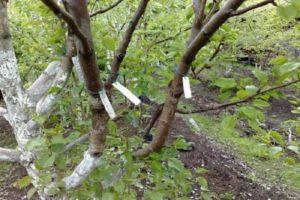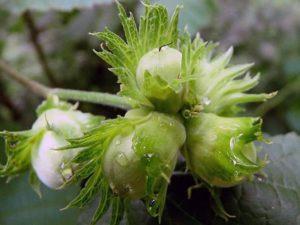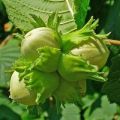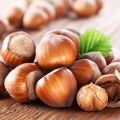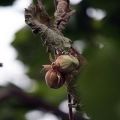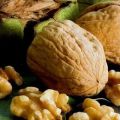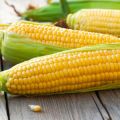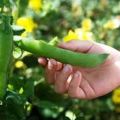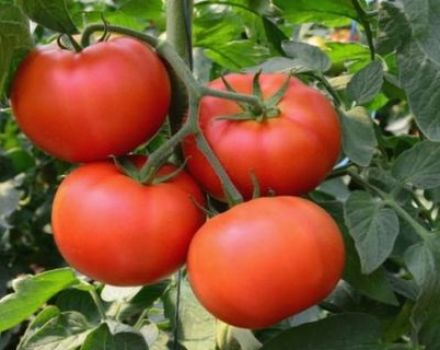25 best varieties of hazelnuts with descriptions and characteristics, cultivation technology and care
Hazelnuts are nuts from the Birch family, among which 20 main types are common. They originally grew in coniferous forests, forming an undergrowth. The fruits were distinguished by their nutritious properties and excellent taste, thanks to which the plants were tried to cultivate and relocate to gardens. The varieties of hazel (hazelnuts) presented by breeders on the market differ not only in seedlings, their size and shape, but also in the characteristics of the fruit, the characteristics of cultivation and care.
Content
- 1 General description and characteristics of the culture
- 2 Hazelnut varieties
- 2.1 Trebizond
- 2.2 Caucasus
- 2.3 Masterpiece
- 2.4 Moscow ruby
- 2.5 Academician Yablokov
- 2.6 Garden
- 2.7 Warsaw red
- 2.8 Firstborn
- 2.9 Barcelona
- 2.10 Anapsky
- 2.11 Isaevsky
- 2.12 American hazel
- 2.13 Masha
- 2.14 Ekaterina
- 2.15 Circassian
- 2.16 Chocolate
- 2.17 Kuban
- 2.18 Roman
- 2.19 Common Siren
- 2.20 Adyghe
- 2.21 Catalan
- 2.22 Lambert white
- 2.23 Cosford
- 2.24 Victoria
- 3 Which variety is better to choose
- 4 Features of planting and care
General description and characteristics of the culture
Nowadays, hazelnuts are called cultivated varieties of wild hazel. The bushes reach a height of 6 m, have a wide spreading crown. The color of the leaf plate ranges from green to dark red, due to which the plant is planted as decorative. The flowering period of hazelnuts falls in December-March.
The roots of hazel are close to the soil surface, so it needs regular watering and fertilization. The shrub perfectly strengthens loose soil on the slopes, has high frost resistance. For pollination, it is necessary to plant nearby bushes of different varieties, since the plant's own inflorescences are unisexual.
Hazelnuts thrive in shaded areas, but require constant shaping and trimming. When the bush is thickened, the yield indicators drop dramatically. After the plant reaches the age of 11 years, you will also need anti-aging pruning. At the moment, more than a hundred varieties of shrubs have been bred, but not all of them are suitable for cultivation in the middle lane due to the low level of cold resistance.
Hazelnut varieties
Hazel, the varieties of which are constantly replenished with new products, has already managed to settle in the plots of domestic gardeners. Based on their feedback, it is possible to establish the most popular varieties of this crop, showing good results when grown.
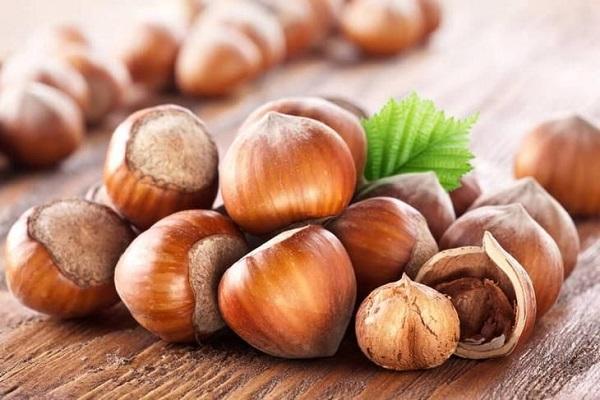
Trebizond
A variety of Georgian origin with a high yield. Nuts are rounded, the shell is dark brown. They contain 72% vegetable fat and weigh only 3 g. Each inflorescence includes up to 6 fruits. The ripening period occurs in the last decade of August. Plant height reaches 5 m. Flowering occurs in February-April. Withstands a decrease in temperature indicators to -32 ° C.
Caucasus
Early ripening variety with emerald green foliage.Plant height up to 3 m, crown of a narrow pyramidal type, which makes the bush compact. Fruits contain 68% vegetable fat, and weigh up to 3 g. The yield from each hectare of plantings is 22 centners of hazelnuts. Grown as a pollinator, suitable for mechanical harvesting. Hazel is zoned for the North Caucasus region, but it is successfully cultivated in all horticultural zones.
Masterpiece
The most productive hazelnuts bred by Ukrainian breeders. It starts bearing fruit within 3 years after planting the shrub. An adult plant gives up to 9 kg of nuts. The ripening period occurs in the last decade of August. The height of the hazel is up to 4 m, the fruits are formed up to 3 g, in each inflorescence there are up to 8 pieces. It needs to be planted next to the pollinator variety, reproduction occurs by cuttings, shoots from the root or by layering. The content of vegetable oils in nuts does not exceed 65%.
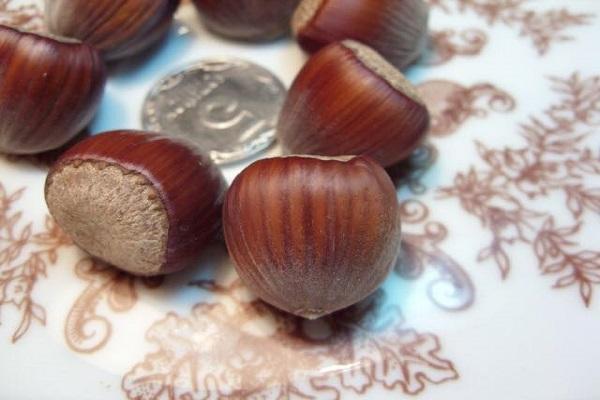
Moscow ruby
The variety was bred in 1957 by academician Yablokov in the conditions of the Zakatala nut farm by crossing the popular Nottingham hazelnuts with the pollen of red-leaved hybrids. It is one of the best hazel trees to grow in gardens. Plant height reaches 5 m, male catkins are highly pollinated, which increases productivity.
It is characterized as cold-resistant hazel. Fruits weigh up to 4 g, in each inflorescence there are up to 15 pieces. When ripe, the nut becomes crimson-red, which matches the color of the foliage in tone. The kernel contains up to 63% vegetable fats. The ripening period of the crop falls on the first ten days of October. Up to 4 kg of fruits are removed from each plant. Both the main bush and the pollinator are grown.
Academician Yablokov
The variety was obtained in 1961 and recommended for cultivation in the northwestern region, but over the years of cultivation has shown good results in other zones, especially in the north. The height of the hazel reaches 4 m. Suffers from damage by a weevil, frost resistance is at an average level. The young plant produces few male-type flowers, but fruiting occurs regularly. Needs to be planted nearby a pollinator variety. Fruits are large, they ripen in the first decade of October.

Garden
Medium-sized ordinary variety with good frost resistance. The fruits ripen in the second decade of September and are small in size. The foliage is green. Cultivated everywhere, requires planting a nearby pollinator variety. The content of vegetable oils in nuts is up to 65%.
Warsaw red
European hazelnut with a large pyramidal bush. The fruits are large, contain up to 73% fat. The ripening period falls in the second decade of September. It is grown not only for the sake of harvesting, but also as an ornamental plant with unusual red foliage. Needs planting of a pollinator variety. Male and female inflorescences of hazel blossom at the same time.
Firstborn
A hybrid variety obtained by the breeder R. F. Kudasheva. The height of the hazel reaches 4 m. Fruits gain weight up to 3 g, collected in inflorescences up to 5 pcs. in everyone. The fat content in the kernels reaches 65%.
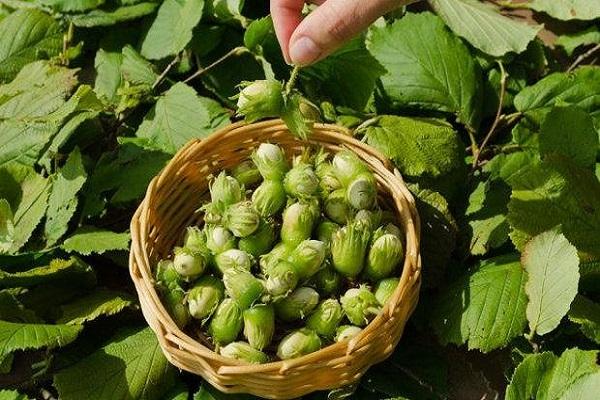
Barcelona
The bush up to 5 m high has a spreading wide crown. The leaf plates are light green in color and large in size. The variety has a high yield, the nuts are large, tasty. They ripen in the first decade of September. Among the shortcomings, the ability to be affected by moniliosis is distinguished. Needs pollinators to be planted nearby. The calorie content of the kernel is higher than that of fish or meat, therefore it is undesirable for overweight people to eat it.
Anapsky
Caucasian variety bred on the Black Sea coast. Ripening occurs in the first decade of September. The inflorescence consists of 2-6 nuts weighing up to 2.5 g. The height of the shrub reaches 4 m. It begins to bear fruit 3 years after planting the shoot. Winter-hardy hazel with average disease immunity.
Isaevsky
Another worthy variety from the breeder Kudasheva. Forms dessert large fruits, is characterized by increased cold resistance (withstands a drop in temperature to -42 ° C). The plant is tall, with a wide crown. Hazelnuts inherited the best qualities of the mother hazel trees Tambovskiy early and Academician Yablokov.

American hazel
A hybrid American hazelnut with a bush height of up to 4 m. Flowering occurs in April-May, and the growing season lasts from April to September. The nut is formed large, sugar. Differs in high cold resistance.
Masha
A hybrid with red leaves obtained by the breeder Kudasheva. Fruits gain weight up to 2 g, are characterized as dessert, average fat content. Hazelnuts can withstand low temperatures and give bountiful harvests.
Ekaterina
Hybrid with red foliage, obtained in 1961. It is considered one of the largest-fruited varieties, the fruits of which gain weight up to 5 g. Each brush contains up to 8 pieces. The ripening period falls in the last decade of September. Requires the obligatory planting of pollinating varieties. High cold resistance.
Circassian
Recognized as a variety of folk selection. The frost resistance of hazelnuts is excellent, not susceptible to the effects of pests and pathogens, suitable for cultivation in arid climates. Nuts are collected in a brush of 5 pieces each. The core contains up to 66% vegetable fats.
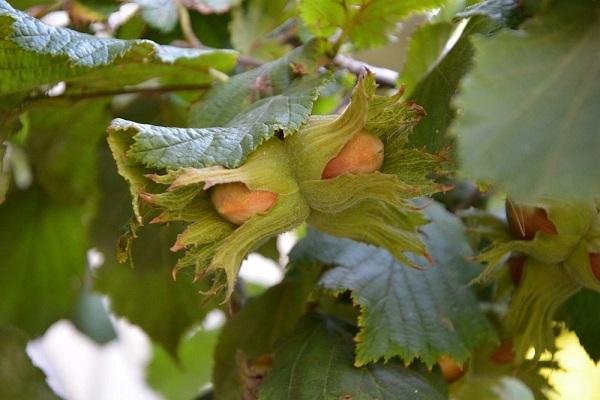
Chocolate
The variety was bred by Ukrainian breeders at the G. Vysotsky Research Institute. A tall plant reaches up to 5 m, the crown is spreading. Flowering occurs in February-April, the ripening period is average. Each fruit contains up to 4 nuts. Hazelnuts can withstand temperatures as low as -37 ° C.
Kuban
Harvesting hazel with high frost resistance. Fruits gain weight up to 4 g. Hazelnuts are zoned for cultivation in the Krasnodar Territory. Each adult plant gives up to 9 kg of nuts. The crop can be harvested mechanically.
Roman
Hazelnuts form fruits weighing up to 4 g. It is immune to common diseases, but needs preventive treatment against bacteriosis. Among the disadvantages are low cold resistance and the likelihood of developing fruit rot.
Common Siren
Polish red-leaved variety, obtained in 1969. The shrub grows up to 5 m in height. In seed fruits there are up to 7 nuts, which begin to ripen by September. Hazelnuts have good frost resistance and bear fruit stably.
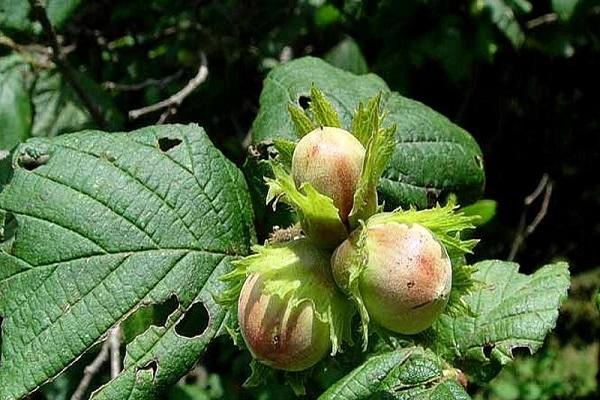
Adyghe
This variety was obtained as a result of the work of the breeder N.A.Tkhagushev in 1967. It has high cold and drought resistance, as well as immunity to common diseases. The fruit contains up to 5 nuts. The core contains up to 65% fat.
Catalan
The bush grows large, leafy. Nuts are formed at the tips of branches up to 6 pieces per seed. Hazelnuts can withstand temperatures as low as -20 ° C. The crop ripens in the last decade of September.
Lambert white
Differs in slow growth of the bush, which is able to reach medium size. In the seed, up to 8 fruits are collected, clothed in a white shell. The ripening period falls on the last decade of August. Hazelnuts are cold-resistant, successfully grown in the climate of the North Caucasus.
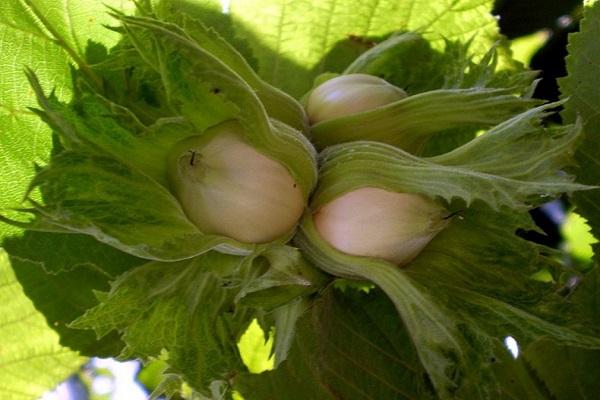
Cosford
An English variety named after the area where it was bred back in 1816. The hazel is high, spreading. The foliage is green in color, but turns red by autumn. The ripening period occurs in the second decade of September. Hazelnuts begin to bear fruit early, require planting nearby pollinating varieties, but they can also be grown as a pollinator themselves.
Victoria
Hazelnuts of Ukrainian selection. A tall shrub that forms up to 8 nuts in each fruit. The ripening period falls in the second decade of September. The plant tolerates cold well, pleases with abundant and stable yields.
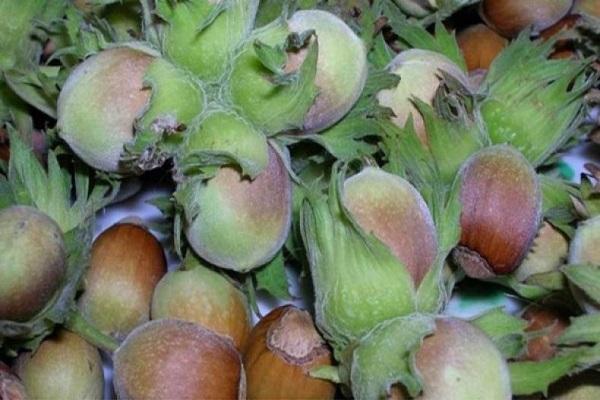
Which variety is better to choose
Hazelnuts for their site are selected, first of all, depending on climatic conditions. Residents of the southern regions prefer drought-resistant varieties, and in the middle lane they grow only cold-resistant plants. Otherwise, the choice of gardeners is completely free. Fruit size, leaf color, taste and yield are selected solely from their personal preferences.
Features of planting and care
Hazelnuts do not like sharp temperature fluctuations, therefore it is advisable to plant it on the eastern and northern parts of the slopes. The plant grows well in the shade. Direct sunlight is destructive for him. With strong darkening, yield indicators fall and decorative qualities may suffer.
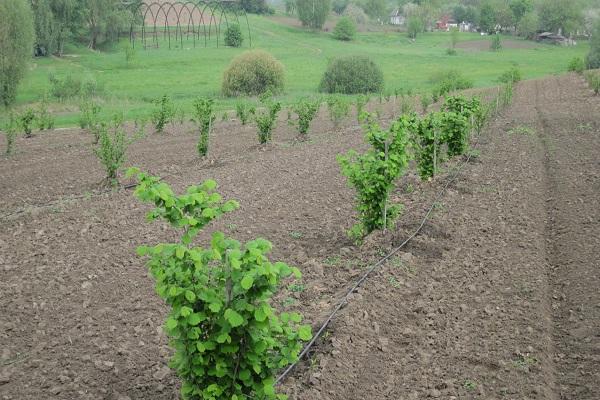
The groundwater level should not approach the surface at the site selected for planting hazel closer than 1.5 m. It is better to choose an area located near buildings, fences. On the south side, planting hazel is undesirable, because the awakening will come too early and the shrub will suffer from frost.
Caring for hazelnuts comes down not only to watering and mulching the soil, but also to making additional fertilizing, pruning. So that the yield does not decrease, it is impossible to allow the branches inside the shrub to thicken. It is also necessary to regularly carry out preventive spraying against pests and diseases.
